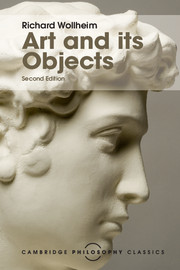Art and its objects
Published online by Cambridge University Press: 05 November 2015
Summary
1
‘What is art?’ ‘Art is the sum or totality of works of art.’ ‘What is a work of art?’ ‘A work of art is a poem, a painting, a piece of music, a sculpture, a novel. …’ ‘What is a poem? a painting? a piece of music? a sculpture? a novel? …’ ‘A poem is …, a painting is …, a piece of music is …’ a sculpture is …‘ a novel is …’
It would be natural to assume that, if only we could fill in the gaps in the last line of this dialogue, we should have an answer to one of the most elusive of the traditional problems of human culture: the nature of art. The assumption here is, of course, that the dialogue, as we have it above, is consequential. This is something that, for the present, I shall continue to assume.
2
It might, however, be objected that, even if we could succeed in filling in the gaps on which this dialogue ends, we should still not have an answer to the traditional question, at any rate as this has been traditionally intended. For that question has always been a demand for a unitary answer, an answer of the form ‘Art is …’; whereas the best we could now hope for is a plurality of answers, as many indeed as the arts or media that we initially distinguish. And if it is now countered that we could always get a unitary answer out of what we would then have, by putting together all the particular answers into one big disjunction, this misses the point. For the traditional demand was certainly, if not always explicitly, intended to exclude anything by way of an answer that had this degree of complexity: precisely the use of the word ‘unitary’ is to show that what is not wanted is anything of the form ‘Art is (whatever a poem is), or (whatever a painting is), or …’
But why should it be assumed, as it now appears to be, that, if we think of Art as being essentially explicable in terms of different kinds of work of art or different arts, we must abandon hope of anything except a highly complex conception of Art?
- Type
- Chapter
- Information
- Art and its Objects , pp. 1 - 102Publisher: Cambridge University PressPrint publication year: 2015



